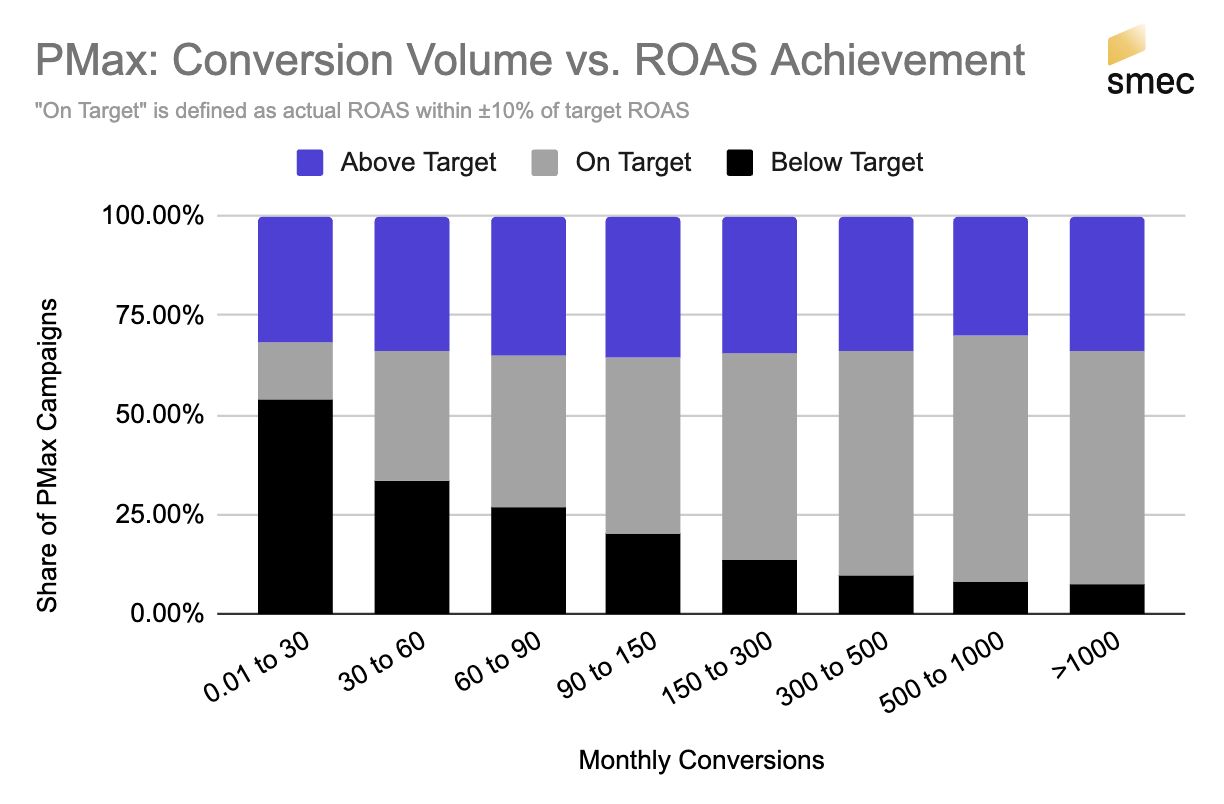In the world of digital marketing, Google’s Performance Max (PMax) stands as a promising beacon of efficiency and optimization. Amidst this buzz and excitement, Mike Ryan, Head of eCommerce Insights over at Smarter eCommerce, asked a crucial question in LinkedIn that crosses the minds of many paid search pros:
How much data does PMax need to truly work its magic?

If you’ve ever ventured into this realm, you’ve probably encountered a spectrum of answers like Mike did, ranging from a mere 15 monthly conversions to a staggering 100. It’s a puzzle that’s been floating around the digital landscape and lots of marketers throw their hands up and say, “We’ll never really know. Google would tell us if they had a good answer.” Well, Mr. Ryan and his team pulled some data to try and crack it.
For those who crave data-driven decision-making like I do, let’s dive straight into the heart of the matter. Mike rolled up his sleeves and gathered a 14,000 data points in pursuit of demystifying the enigma of PMax’s data appetite.
Here’s the resulting graph of what he found:

Is There a Magic Number of Conversions for PMax to Beat ROAS Goals?
In a world of instant gratification, I won’t keep you hanging. The answer is a bit more intricate than a simple numeric value. So, let’s break it down step by step.
The Short Answer: For every “conversion bin” in PMax, there’s a percentage of PMax campaigns that either hit the efficiency bullseye or missed the mark.
The Long Answer: The data represents the first half of 2023 – a time of immense change and evolution in the digital marketing landscape. Armed with his arsenal of information, Mike extracted key metrics, including monthly conversion figures, average Return on Ad Spend (ROAS) targets, and the actual ROAS achieved.
Here’s how Mike explained it in his LinkedIn Post:

But that’s just the beginning. The real magic happened when he clustered campaign-month pairs. How? Based on conversion volume and the delightful dance of whether the actual ROAS met, exceeded, or fell shy of the target ROAS. Yes, folks, we’re getting granular.
What Does the Data Say About PMax?
On the bright side: As conversion volume increases, on-target performance grows at the expense of below-target performance. This is a proof of concept for what Google claims about PMax – that it will favor higher performance and shift budget accordingly.
There seems to be a floor: Campaigns with 30 or fewer conversions are akin to playing darts with a blindfold. You’re bound to miss the bullseye more often than not. The data shows a high variance of results at these levels of conversion.
An ambiguous middle ground: When looking at campaigns with a conversion counts between 60 and 90, your odds of missing, meeting, or exceeding your ROAS target are oddly similar. It’s a tricky terrain.
A wrench in the analysis: One out of every three PMax campaigns exceeded their ROAS targets. This held true across all conversion volumes.
Cracking the PMax ROAS Efficiency Code
Now, let’s tackle the heart of the matter. You might have stumbled upon articles or experts suggesting that PMax can work wonders with a mere 15 or 20 monthly conversions. But you should be skeptical. When it comes to the playground of data, my fellow marketers, more is unequivocally more. Sure, PMax looks to beat targets about one third of the time regardless. But, the outcomes become more reliable and predictable when we’re talking about 150 conversions and beyond.
And steady, reliable performance is what we should be looking for in today’s eCommerce landscape.
A word of caution: Mike didn’t factor in cost/margin data into this analysis. We know how important margins are for analyzing ROAS, so take this for what it is: an interesting look behind the data curtain of PMax.
This correspondence between data volume and a respectable monthly budget might seem like a cosmic alignment, but it’s a tale as old as time in the world of digital advertising.
So, fellow data voyagers, what have we learned today? PMax, the wonder tool Google raves about, thrives on data like a fish does in water. The next time someone throws around a numeric threshold, you can proudly steer the conversation toward the realm of nuance and robustness.
In the quest for digital mastery, let’s remember – in data we trust, and in data we excel.

